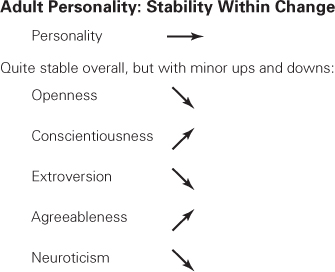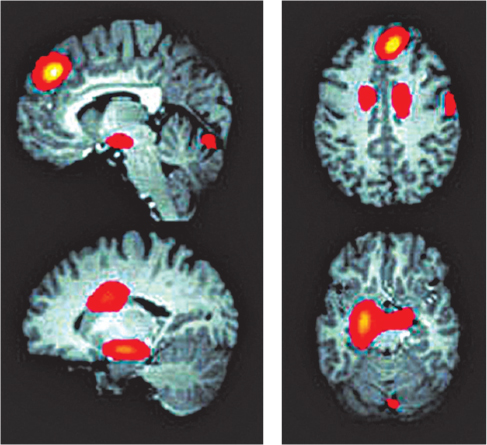13.1 Personality Development in Adulthood
A mixture of genes, experiences, and contexts results in personality, which includes each person’s unique actions and attitudes. Continuity is evident: Few people develop characteristics that are the opposite of their childhood temperament. But personality can change as people deal with adversity and challenge.
Theories of Adult Personality
To organize the discussion of this mix of embryonic beginnings, childhood experiences, and adulthood contexts, we begin with theories.
Erikson and MaslowErikson originally envisioned eight stages of development, three of which occur after adolescence. He is praised as “the one thinker who changed our minds about what it means to live as a person who has arrived at a chronologically mature position and yet continues to grow, to change, and to develop” (Hoare, 2002).
Erikson’s early stages, described in previous chapters, are each tied to a particular chronological period. But late in his life, Erikson stressed that adult stages do not occur in lockstep. Adults of many ages can be in the fifth stage, identity versus role confusion, or in any of the three adult stages—
| Unlike Freud or other early theorists who thought adults simply worked through the legacy of their childhood, Erikson described psychosocial needs after puberty in half of his eight stages. His most famous book, Childhood and Society (1963), devoted only two pages to each adult stage, but published and unpublished elaborations in later works led to a much richer depiction (Hoare, 2002). Identity Versus Role Confusion Although Erikson originally situated the identity crisis during adolescence, he realized that identity concerns could be lifelong. Identity combines values and traditions from childhood with the current social context. Since contexts keep evolving, many adults reassess all types of identity (sexual/gender, vocational/work, religious/spiritual, political, and ethnic). Intimacy Versus Isolation Adults seek intimacy— Generativity Versus Stagnation Adults need to care for the next generation, either by raising their own children or by mentoring, teaching, and helping others. Erikson’s first description of this stage focused on parenthood, but later he included other ways to achieve generativity. Adults extend the legacy of their culture and their generation with ongoing care, creativity, and sacrifice. Integrity Versus Despair When Erikson himself was in his 70s, he decided that integrity, with the goal of combatting prejudice and helping all humanity, was too important to be left to the elderly. He also thought that each person’s entire life could be directed toward connecting a personal journey with the historical and cultural purpose of human society, the ultimate achievement of integrity. |
Similarly, Abraham Maslow (1954) refused to link chronological age and adult development when he described a hierarchy of needs with five stages achieved in sequence (see Chapter 1, Figure 1.11). Completion of each stage allows a person to move ahead.
463
As an example, people who are in Maslow’s third level (love and belonging, similar to Erikson’s intimacy versus isolation) seek to be loved and accepted by partners, family members, and friends. Without affection, people might stay stuck at this level. By contrast, those who experience abundant love are able to move to the next level, success and esteem. The dominant need at this fourth stage is to be respected and admired.
For humanists like Maslow, these five drives characterize all people, with most adults seeking love or respect (levels three and four). Unless mired in poverty or war, people move past Maslow’s lower two stages (safety and basic needs) by adulthood.
Other theorists agree, sometimes describing affiliation and achievement, sometimes using other labels. We will soon use Erikson’s terms, intimacy and generativity, as a scaffold to describe these two universal needs. Every theory of adult personality recognizes that both are important in adulthood.
The Midlife CrisisNo current theorist sets chronological boundaries for specific stages of adult development. Middle age, if it exists, can begin at age 35 or 50. This contradicts the theory of the midlife crisis, thought to be a time of anxiety and radical change as age 40 approaches. Men, in particular, were said to leave their wives, buy red sports cars, and quit their jobs because of midlife panic. The midlife crisis was popularized by Gail Sheehy (1976), who called it “the age 40 crucible,” and by Daniel Levinson (1978), who said men experienced
tumultuous struggles within the self and with the external world.…Every aspect of their lives comes into question, and they are horrified by much that is revealed. They are full of recriminations against themselves and others.
[Levinson, 1978]

However, no large study over the past three decades has found evidence of a normative midlife crisis (Austrian, 2008). In hindsight, it is easy to see where Sheehy and Levinson went astray. Levinson studied just 40 men, all from one cohort, and the data were then analyzed by men who were also middle-
The initial research on midlife crises was conducted in the early 1970s. Men who reached age 40 during that time period were affected by historic upheavals in their families. Many began marriages and careers in the 1950s with particular expectations of their children, wives, and careers. Instead, the first wave of feminism took place when they reached middle age. As a result, women’s views of family and career changed dramatically. Although the researchers concluded that the men were experiencing a crisis as a result of their age, in fact it was as a result of historical circumstances.
Regardless, the concept of midlife crisis continues to be referenced in popular movies, books, and songs. A 2013 Google search found more than 19 million hits for “midlife crisis.” In popular culture, midlife crisis is used to explain almost every aspect of adult personality, health, careers, and relationships. However, the reality is that as we get older, we must inevitably deal with loss, failure, and relationship problems. Most people who reach age 40 do not have a midlife crisis.
464
Personality Traits
Remember from Chapter 4 that each baby has a distinct temperament. Some are shy, others outgoing; some are frightened, others fearless. Such traits are affected by experiences, but they begin with genes.
The Big FiveTemperament does not vanish: Researchers find substantial, even astonishing, coherence in personality throughout life. There are hundreds of examples. One recent study found, for instance, that temperament at age 3 predicted gambling problems at age 32 (Slutske et al., 2012).
Longitudinal, cross-
- Openness: imaginative, curious, artistic, creative, open to new experiences
- Conscientiousness: organized, deliberate, conforming, self-
disciplined - Extroversion: outgoing, assertive, active
- Agreeableness: kind, helpful, easygoing, generous
- Neuroticism: anxious, moody, self-
punishing, critical.
Each person’s personality is somewhere between extremely high and extremely low on each of these five. The low end might be described, in the same order as above, with these five adjectives: closed, careless, introverted, hard to please, and placid.
ESPECIALLY FOR Immigrants and Children of Immigrants Poverty and persecution are the main reasons some people leave their home for another country, but personality is also influential. Which of the Big Five personality traits do you think is most characteristic of immigrants? 
Extroversion and neuroticism, according to one study (Silventoinen et al., 2008). Because these traits decrease over adulthood, fewer older adults emigrate. 
These five clusters not only affect career choices and health habits, as expected, but also much more. Adults choose their social context, or ecological niche, selecting vocations, hobbies, mates, and neighbourhoods at least in part because of personality traits. Even the decision to retire and the reaction to retirement are related to the Big Five (Robinson et al., 2010).
Among the factors linked to the Big Five are education (conscientious people have higher rates of post-
International research confirms that all human personality traits (there are hundreds of them) can be grouped in the Big Five. Of course, personality and behaviour are influenced by many other factors, not only gender and cohort as seen above, but also culture. It would be foolish to predict college or university graduation or voting behaviour or anything else solely on a person’s rank on the Big Five.

Indeed, anyone might act in uncharacteristic ways if circumstances are dramatically altered—
Thus, new events sometimes bring out old personality patterns. People might divorce and then remarry someone like the old partner, for instance, or find a new job that reflects their personality rather than change their personality to fit the job. In general, people are most comfortable when their personality fits with their partners, their neighbours, and their careers. For instance, one study found that people high in neuroticism tend to work in hazardous conditions—
465

KAI-
Even happiness seems a matter of personality more than circumstances. Adults who experience things that temporarily make them overjoyed (e.g., winning a lottery) or depressed (e.g., losing a loved one) often revert to the level of happiness they had before that event. Personality trumps experience (Gilbert, 2006).
Culture, Age, and ContextMany researchers who study personality find that people adapt to their culture, expressing personality traits differently in, say, Egypt or Ecuador (Church, 2010). Traits that are considered pathological in one place (such as neuroticism in North America) tend to be modified as people mature within that community (L. A. Clark, 2009). By contrast, traits that are valued (such as conscientiousness) endure.
That is exactly what was found in a massive longitudinal study of midlife North Americans (called MIDUS). Agreeableness and conscientiousness increased slightly overall while neuroticism decreased, as did openness and extroversion (which may be more appreciated in the young than the old) (see Figure 13.1) (Lachman & Bertrand, 2001). This pattern was also found in other research (Allemand et al., 2008; Donnellan & Lucas, 2008).

Since cultural values interact with personality traits, it should also be noted that the terms used to describe personality are not neutral. For instance, “open” seems a positive trait and “closed” seems negative. But instead of closed, perhaps another term, such as traditional, might be a more accurate descriptor.
The relationship between enduring personality and changing context was evident in a longitudinal study that tracked women in the United States from ages 20 to 70 (George et al., 2011). When women were in college in the 1950s, they expected to become wives and mothers, not employees. In the 1960s, the culture shifted—
The relationship between personality and context are evident not only in careers, but also in family structure. For both men and women born in 1920, those high in openness had about the same number of children as those low in that trait. For those born in 1960, however, the more open a person was, the fewer children he or she had. They were open to non-
466
OPPOSING PERSPECTIVES
Local Context Versus Genes
Some people believe that personality is so powerfully shaped by regional culture that a baby will have a different personality if born and raised in, say, Canada or Mexico. The opposite hypothesis is that personality is innate, fixed at birth, and impervious to social pressures with only minor, temporary impact from culture.
Evidence for the second hypothesis includes the fact that the same Big Five traits are found in many nations, with similar age-
Further evidence that personality is inborn, not made by context, is the stability of personality throughout adulthood (B. W Roberts et al., 2006; Specht et al., 2011). Extroverted emerging adults become outgoing seniors, with many friends from early adulthood and with more new friends along the way. Other traits likewise endure, in new forms.
Other research, however, finds that culture and events change personality. For example, according to some social scientists, Asian cultures encourage a sixth personality dimension, called dependence on others, which should be added to the Big Five when studying Asians (Hofstede, 2007; Okazaki et al., 2009; Suh et al., 2008).

Asian children who seem low on this trait are encouraged by their culture to increase it, so cooperation is more common among Asian adults than among children. Since we now know that brain structures respond to experience, the childhood context—
When Asian adults emigrate to a culture in which that trait is less valued, they may be considered too docile and overly concerned with blending in. This would not be true for Asians who emigrated as babies and were raised in the individualistic culture, unless their parents were strongly opposed to new cultural influences and raised their children as they themselves had been raised. Clinicians find that personality tests developed for native-
Another example of personality change is in the Big Five trait of openness. Cultures differ in the extent to which they consider openness desirable. In some cultures, openness is prized as an indication of intelligence and willingness to learn. Children who ask questions in class are appreciated. However, in some places interpersonal harmony is more valued than individual initiative (Church, 2010). For instance, one group of researchers concluded: “Openness is not commonly used as a distinct dimension in the taxonomy of personality traits in Chinese culture” (Cheung et al., 2008). In this case, children are discouraged from impulsively “interrupting” with questions.
The idea that context shapes personality is highlighted in a U.S. study that found that the Big Five scores differ among adults in the 50 states (Rentfrow et al., 2008). According to the answers of 619 397 respondents to an Internet survey that asked questions about their traits, New Yorkers are highest in openness, New Mexicans highest in conscientiousness, North Dakotans highest in both extroversion and agreeableness, and West Virginians highest in neuroticism. Lowest in these five are, in the same order, residents of North Dakota, Alaska, Maryland, Alaska (again), and Utah.
This suggests that local norms, institutions, history, and geography also have an impact on personality. For example, residents of Utah include Mormons (a culture that does not use drugs, has large families, and are generally in good health) and awesome mountains. That might make them less anxious and more serene, resulting in low levels of neuroticism. In contrast, New York is multi-
467
Before concluding that environment shapes personality, however, consider the opposite idea—
A decades-
A consensus regarding the relationship between culture, geography, genes, and personality has not yet emerged (Church, 2010). As you see, both opposing views make sense: More longitudinal research is needed.
KEY Points
- Adults seek intimacy and generativity (Erikson) or love and respect (Maslow).
- The Big Five personality traits (openness, conscientiousness, extroversion, agreeableness, neuroticism) are evident worldwide.
- Adult personality shows both continuity with childhood temperament and change in reaction to life circumstances.
- Personality traits affect adults’ choices of partners, jobs, and life patterns.